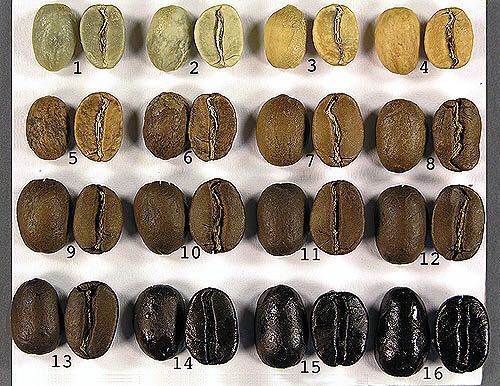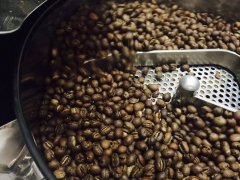Is the mixed Italian blending of coffee beans raw or familiar?

People need to put coffee from different places together for several different purposes.
First, the mixing of coffee beans people need to combine coffee from different places for several different purposes. The ideal goal, of course, is to piece together a coffee that tastes better than any of them. But generally speaking, Arabica coffee from a single origin is enough to make coffee that tastes good for export; it has a delicate flavor, a soft taste and a sweet aftertaste. So there is no need for "blending" (that is, putting together coffee from different places). The main commercial purpose of blending coffee is to reduce costs and mix coffee with coffee that is not very good. In order to improve sales profits. There is also a possible purpose, that is to put together a unique taste, the unique taste of a brand. Customers who like this taste have to go to this factory to buy it, but can't get it from other suppliers. Another advantage of this is that the taste of the blended coffee will not change no matter how the taste of the coffee from different years and places of origin changes. Here we ignore other possible commercial purposes and concentrate on understanding the blending for the purpose of improving the taste and quality of coffee. Before blending any coffee, you should first understand the taste characteristics of all kinds of coffee, and at least make it clear in your heart that the taste of the kind of coffee you want to mix can not be achieved by any single coffee. It would be a pity if the blended coffee doesn't taste better than one or more of them. It would be better not to match. If you use some pretty good quality coffee for blending, the result is likely to be so. Although some fixed varieties of coffee can be drunk directly as individual coffee, most coffee has more or less defects in flavor, such as no special flavor, lack of depth, not strong enough or a certain flavor is too strong. In order to make up for these deficiencies, it is necessary to combine several kinds of coffee beans with different characteristics to create a harmonious and deep flavor. Some people think that the fun of coffee is focused on baking and blending, while drinking coffee is just enjoying the fruits of your own victory. Blending coffee is not a random mix of coffee beans. Sometimes the blending of two kinds of boutique coffee will suppress each other's unique flavor, so blending is not simply blending several kinds of boutique coffee together. Matching is just like a painter adjusting and creating charming colors in a palette, so the mixer can also blend with coffee beans to produce an attractive flavor. Therefore, it is not too much to say that matching is an art. as an artist, the assembler needs not only experience and inspiration, but also through certain scientific calculation. The emergence of works of art will not be accidental, but the outbreak of long-term accumulation. The average mixed coffee does not need to use more than five kinds of caffeine beans. Because if there are too many kinds of coffee beans, the situation can be very complicated. Almost only a very special expert would not be confused by so many different coffee beans.
Second, the relationship between matching and baking
Do you want to bake and then mix, or do you want to mix and bake first? Which way is better?
If you have a definite recipe, of course the easiest way is to put different coffee beans together and then bake them together. But if you are trying and comparing different ingredients and proportions, you certainly want to bake all kinds of coffee beans before trying. Otherwise, every time you change the composition and proportion of the mix, you need to bake it again.
For "Vienna Coffee" (Melange) blending and small test blending, it is more suitable for independent roasting. For example, when a small amount of "Rob Coffee" needs to be added in a trial mix, the required "Rob Coffee" is the most suitable for independent roasting.
Some coffee is denser or changes in volume before and after roasting, and these beans are roasted differently from "washed" Arabica coffee. Arabica Coffee processed by the "drying method" is baked at a higher temperature. But in most cases, all kinds of coffee beans can be roasted together.
In general, all coffee beans can be roasted together. You need to consider using independent baking only when the baking effect is not ideal. At this time, independent baking can usually achieve better results. Especially for drum roaster, a relatively moderate baking degree can be found in general.
But some individual coffee beans are not easy to bake evenly. For example, Yemeni coffee, Ethiopian DP coffee beans, and so on. The uneven baking color is not a defect, only the "washed" Arabica coffee needs to be roasted evenly.
General steps and principles of matching
Before matching, we should be clear about the following points:
1. The theme of matching
What kind of flavor you want to match, that is, to determine the goal of the match.
two。 Understand the characteristics of each coffee bean
To mix coffee, you must first be familiar with the characteristics of each individual coffee and understand the subtle relationship between roasting and coffee flavor, all of which can only be achieved by tasting the cup.
3. Determine the task of participating in the blending of coffee beans
Since a variety of coffee beans are used together, it is necessary to know whether the task of each kind of coffee beans is to make her show soft bitterness, distinct acidity or thick mellow taste, etc.
Generally speaking, the following principles should be followed when matching:
1. Blending of raw beans requires the use of coffee beans with their own characteristics, and avoid using coffee beans with similar flavor. The choice of raw beans can be considered from three aspects:
Raw bean treatment method: that is, whether raw beans are treated by washing method or drying method, which has a lot to do with the flavor of coffee beans.
Producing areas of raw beans: coffee producing areas are generally divided into three major regions, including about 20 countries in Central and South America, namely, Brazil, Colombia, Guatemala, Mexico, Delvado, Jamaica and Peru, and about 10 countries in Southeast Asia, namely India, Indonesia (including Java and Sumatra) and Papua New Guinea. About 25 countries in the Arab and African regions, namely, Ethiopia, Kenya, Tanzania, Arabia, Uganda and so on.
Coffee bean flavor: refers to the coffee bean flavor of sour, bitter, sweet, alcohol which is more prominent, or all aspects of more balanced neutral beans. Now the most commonly used raw beans are Brazil, Colombia and Mocha.
two。 The number and proportion of coffee beans involved in blending
Since it is a blending, it naturally refers to the blending of more than two kinds of raw beans, but a special example is that it can also match the same kind of coffee beans with different roasting degrees, or even the new crop and aged coffee or old crop of the same kind of coffee beans, so the type referred to in the blending is no longer a coffee variety in a narrow sense, but extends to the flavor of coffee in a broad sense. Generally use 2 to 6 kinds of coffee beans when blending, too many kinds will not be able to show the unique flavor of coffee. Blended coffee usually does not take the 1:1 blending ratio, because this may suppress each other's unique flavor, so the blending must be primary and secondary in order to produce a better taste than a single coffee. If you want the coffee to taste complex and changeable, you can reduce the proportion of raw beans, and vice versa.
3. The blending of coffee depends on constant attempts, so a blending schedule should be drawn up mathematically before blending, and then the best plan should be determined through the process of blending-tasting cups. Don't think that this is a negative and stupid approach. In fact, a good cup of coffee can only be made by the experience, inspiration and tireless attempt of the blender.
Important Notice :
前街咖啡 FrontStreet Coffee has moved to new addredd:
FrontStreet Coffee Address: 315,Donghua East Road,GuangZhou
Tel:020 38364473
- Prev

Coffee and nutritious coffee contain a small amount of nutrients
Coffee contains a small amount of nutrients. Every 100 grams of coffee beans contain 2.2 grams of moisture, 12.6 grams of protein, 16 grams of fat, 46.7 grams of sugar, 9 grams of cellulose, 4.2 grams of ash, 120 milligrams of calcium, 170 milligrams of phosphorus, 42 milligrams of iron, 3 milligrams of sodium, 0.12 grams of vitamin B2, 3.5 milligrams of nicotinic acid, 1.3 grams of caffeine and 8 grams of tannins.
- Next

The taste of coffee is briefly introduced. There are as many as 18 kinds of smell.
The taste of coffee generally includes three aspects: smell, taste and taste. There are 18 kinds of odors: animal, ash, coke, chemicals, chocolate, caramel, roasted sweet potato, earth, flowers, fruit, grass and vegetables, almonds, sour rot, rubber, spicy, tobacco, wine, wood. The most basic tastes are: sour and bitter
Related
- Detailed explanation of Jadeite planting Land in Panamanian Jadeite Manor introduction to the grading system of Jadeite competitive bidding, Red bid, Green bid and Rose Summer
- Story of Coffee planting in Brenka region of Costa Rica Stonehenge Manor anaerobic heavy honey treatment of flavor mouth
- What's on the barrel of Blue Mountain Coffee beans?
- Can American coffee also pull flowers? How to use hot American style to pull out a good-looking pattern?
- Can you make a cold extract with coffee beans? What is the right proportion for cold-extracted coffee formula?
- Indonesian PWN Gold Mandrine Coffee Origin Features Flavor How to Chong? Mandolin coffee is American.
- A brief introduction to the flavor characteristics of Brazilian yellow bourbon coffee beans
- What is the effect of different water quality on the flavor of cold-extracted coffee? What kind of water is best for brewing coffee?
- Why do you think of Rose Summer whenever you mention Panamanian coffee?
- Introduction to the characteristics of authentic blue mountain coffee bean producing areas? What is the CIB Coffee Authority in Jamaica?

